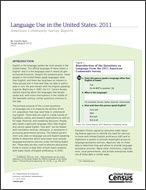Language Use in the United States: 2011
Language Use in the United States: 2011
Introduction
English is the language spoken by most people in the United States. The official language of many states is English/1 and it is the language used in nearly all governmental functions. Despite this predominance, many people in the United States speak languages other than English, and there has long been an interest in these groups and in how well they are able to participate in civic life and interact with the English-speaking majority. Beginning in 1890, the U.S. Census Bureau started inquiring about the languages that people spoke and, with some interruptions in the middle of the twentieth century, similar questions continue to this day.
The primary purpose of the current questions on language use is to measure the portion of the U.S. population that may need help in understanding English. These data are used in a wide variety of legislative, policy, and research applications as well as for legal, financial, and marketing decisions. People who speak a particular language other than English and cannot speak English “very well” can be helped with translation services, education, or assistance in accessing government services. The federal government uses data on language use and English-speaking ability to determine which local areas must provide language-assistance services under the Voting Rights Act. These data are also used to allocate educational funds to states to help their schools teach students with lower levels of English proficiency. In 2000, President Clinton signed an executive order requiring federal agencies to identify the need for services to those with limited English proficiency (LEP) and to implement a system to provide meaningful access to language-assistance services. Agencies rely on these data to determine how and where to provide language-assistance services.2 Many other institutions, organizations, local governments, and private enterprises make use of these data in similar ways.
The Census Bureau collected language data in the 1980, 1990, and 2000 decennial censuses using a series of three questions asked of the population 5 years old and over. The first question asked if the person spoke a language other than English at home. Those who responded “yes” to this question were then asked to report the language that they spoke. The Census Bureau coded these responses into 381 detailed language categories. The third question asked how well that person spoke English, with answer categories of “very well,” “well,” “not well,” and “not at all.” Beginning in 2010, the questions were no longer asked on the decennial census. These same three questions (Figure 1) are now asked each year on the American Community Survey (ACS), which is the primary source of language data.
This report relies primarily on data from the 2011 ACS. Language and English-speaking ability questions that were historically collected once every 10 years in the decennial census are now captured annually in the ACS. The ACS collects information from a large annual sample of approximately 3 million housing unit addresses and therefore provides more reliable statistics. The ACS is administered to a sample of the entire resident population, including those living in group quarters, which makes most estimates from the ACS comparable with those from earlier censuses.3 Taking advantage of this fact, the report also provides a historical look at languages other than English spoken in the United States since 1980. The report also looks at characteristics of the population speaking a language other than English. The ACS also provides reliable estimates for small levels of geography, including counties, cities, and tracts, allowing exploration of the distribution of language use across states and metropolitan areas of the United States.
__________
1 Schildkraut, Deborah, 2001, “Official-English and the States: Influences on Declaring English the Official Language in the United States,” Political Research Quarterly, Vol. 54, No. 2: pp. 445–457.
2 See <www.lep.gov>.
3 A paper comparing ACS data to census data was prepared by the Census Bureau in 2008. See <www.census.gov/library/working-papers/2008/acs/2008_Shin_01.html>.
Appendix Tables
Margins of Error for
Margins of Error for Languages Spoken at Home
Margins of Error for Distribution of Speakers of Non-English Languages
Others in Series
Publication
Publication
Publication





